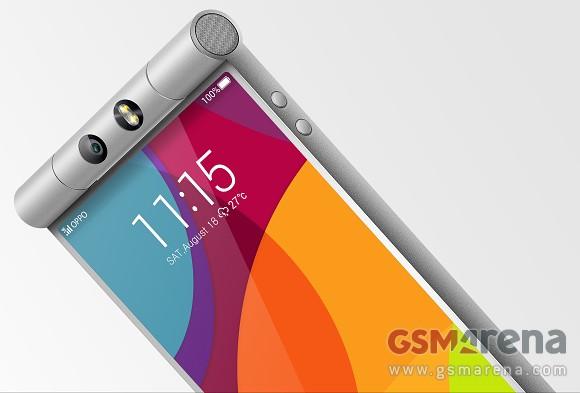Oppo, the firm behind the crazy N1 smartphone with its rotating camera module, is back with the equally mad Oppo N3. Leaked and teased over the past few months, the new device has been made official at an event in Singapore. Its claim to fame? A motorized rotating camera module.
Rather than manually flipping the lens round to alternate between rear and front-facing views, a swiping gesture in the camera app sees the module quickly spin round, reducing the need to reposition the phone, or your face in the viewfinder. It’s also handy for taking panoramic photos, because the lens now moves itself. It’s quirky, unique, probably pointless, and utterly mad. We love it.
A new O-Click remote control comes with the N3, and the updated controls can be used to move the lens around, letting you explore new ways of taking photos. The main benefit of the N3’s rotating module is all your pictures will be taken with the same 16-megapixel, f2.2 Schneider-Kreuznach-lensed camera. Oppo has installed a software package it calls Ultra Image 2.0, which includes a slow motion mode, an ultra macro mode, manual operation, and an HD Picture mode for creating highly detailed, 64-megapixel images. Other features include 4K video recording, and the ability to shoot images in RAW.
The N3’s screen measures 5.5-inches and has a 1080p resolution, while the processor is a quad-core Snapdragon 801, along with 2GB of RAM and 32GB of internal storage memory. The device is quite thick at 9.9mm, and it weighs 192 grams. Oppo has fitted its “Skyline” notification light at the bottom of the aluminum chassis. On the rear of the phone is a new fingerprint sensor, replacing the touch sensitive panel found on the N1. This time it can be used to unlock the device, and secure files and photos, the latter of which can be done straight after they’ve been taken.
How much will you pay for the Oppo N3? It’s priced at $650 without a contract, and it should be available before the end of the year, although an exact release date hasn’t been confirmed. Finding the phone in a local store is highly unlikely, but Oppo has its own online shop for selling its hardware, so it won’t be too hard to seek out if you’re tempted.
CONTINUE TO PAGE TWO FOR ALL THE RUMORS, TEASES, AND LEAKS ABOUT THE OPPO N3
Oppo first broke with tradition when it introduced the Oppo N1, a smartphone with a high-resolution, rotating camera for taking better selfies. Now it seems that the Chinese smartphone maker is gearing up to introduce an even more wild-looking device with a evolution of the N1’s rotating camera.
Updated on 10-13-2014 by Malarie Gokey: Oppo posts official press photo of N3 on social media.
After teasing the release of its new selfie-focused smartphone, Oppo finally announced that it will launch the N3 on October 29 in Singapore. Oppo first teased the N3 in a Google+ post a month ago, but we still don’t know many details about the phone. Information is limited to the hints Oppo has posted on social media and a few leaked press renders. The company is well known for issuing several teaser updates on social media prior to launch, so it pays to keep an eye on Oppo’s Google+ and Facebook accounts.
As OPPO prepares for the next great step, Singapore opens its arms for the N3 launch! #OPPON3 pic.twitter.com/h9vD6wCzOQ
— OPPO (@oppo) October 9, 2014
Oppo officially revealed the design of the N3 in a post on its various social media accounts. Based on the picture, the N3 will have a metal frame and perhaps a plastic back with a small faux leather insert near the camera.
It’s Your Turn. #OPPON3 pic.twitter.com/ppI6UP5XAV — OPPO (@oppo) October 13, 2014
It looks as though the camera will sport a dual LED flash. The resolution of the rotating camera is still unknown, but it is likely to be very high-resolution, seeing as it’s one of the phone’s main features. The device is said to be made of an “aerospace-grade” material. According to recent reports, it seems there will be two versions of the Oppo N3: one made of stainless-steel and one with a case made from an aluminium-lithium alloy.
The design looks markedly different from an earlier image that was leaked to GSM Arena in September showing what was then believed to be the N3. The images appeared to be press shots that showed the rotating camera module prominently.

The Oppo N1 hid the rotating camera by incorporating the module into the top of the device — it didn’t stick out at all. At first glance, you almost didn’t even notice it. Not so with the device pictured below. The phone itself appears thin and the rotating camera rests in a cylindrical bulge at the top of the device. The design is similar to that of the Lenovo Yoga tablets with built-in kickstands. Now it seems that this image is of another device entirely, if it’s real at all.
Previous updates:
Updated on 10-09-2014 by Malarie Gokey: Oppo will launch the N3 at an October 29 event in Singapore.


